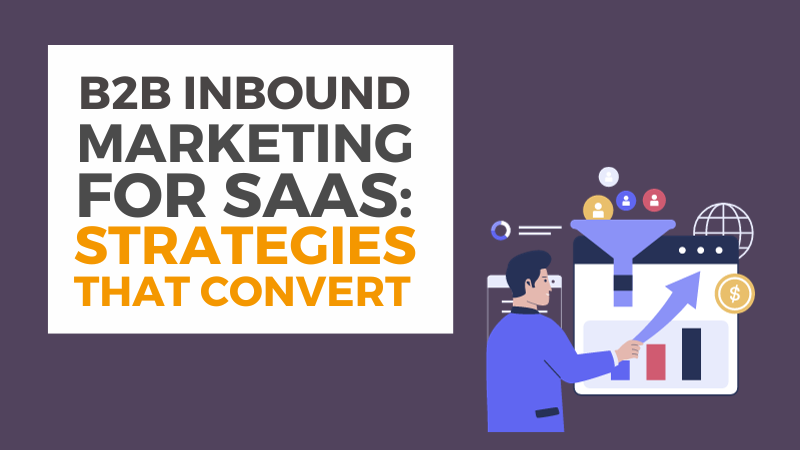What is inbound marketing? Why is it particularly effective for SaaS companies? And how do you make it work for you? Here’s our guide.
Related Aricles:
7 B2B SaaS Digital Marketing Strategies To Achieve Success
Scaling Success: Marketing Automation Tactics for SaaS Companies
Maximising Reach: 7 Effective SaaS Social Media Strategies
Mastering B2B SaaS Lead Generation: 7 Strategies That Work
What is inbound marketing?
Let’s go right back to the beginning.
Marketing is the process of taking your products or services to market. It’s what ensures that, after you’ve spent years developing that SaaS product, there’s someone interested in buying it when it hits the ‘shelves’.
Outbound marketing pushes marketing messages towards people wherever they are. It’s the billboard ad, the mailshot or the TV ad that makes nothing but the most basic attempt at targeting the right message at the right people (for example, by aiming at everyone on your mailing list). It’s the scattergun effect. Show enough people your ad and you might encourage a few of them to bite.
This sort of generalised messaging can be effective. If I drive by a billboard for a fast-food outlet near me, there’s a chance I’ll spin the car round on impulse. But SaaS isn’t like a McFlurry. I probably won’t buy it on impulse. And I probably won’t do it because a billboard told me to.
For that, we need inbound marketing. Inbound marketing pulls a reader in, inviting them to explore and learn about your product or subject area and build a relationship via a blog, videos, your podcast, white papers or other content you create.
The end goal is to sell, but none of the inbound marketing content you generate is overtly sales orientated.
Why does inbound marketing work so well for SaaS?
Inbound marketing is particularly good for SaaS products. Or perhaps, to put it another way, outbound marketing is particularly bad for SaaS products when you don’t already have a relationship with or knowledge of the brand doing the advertising.
I know QuickBooks, for example. Microsoft 365. Norton AntiVirus. You probably do too. So a simple outbound ad might be all we need to tell us that the latest version is now available.
But most SaaS products — and all new SaaS products from brands that don’t have immediate consumer recognition — need more.
That’s because SaaS products are typically difficult to explain in a single, ad-friendly phrase. There’s more to unpack. There’s greater depth to uncover.
Take Zoom. At time of writing, the teleconferencing specialist’s current hero message is ‘AI that makes you more productive’. Which raises more questions than it answers. What AI? What does it do? How does it make you more productive? How can you use that?
It’s a perfect example of the SaaS marketing challenge. To find answers, you need to dig deeper. And that’s for Zoom. How much more digging is required when yours is a SaaS product nobody has ever heard of?
Inbound marketing helps address that challenge in a range of ways:
It informs and educates
Inbound marketing gives you the chance to explain your SaaS product in detail. Whether it’s a case study, a review, a product test drive or simply a feature/benefits sheet, it’s a chance to showcase your product’s capabilities, to answer the ‘so what?’ and build a powerful picture of just how essential your product is.
It builds reputations
Your SaaS product sounds convincing, but what about the organisation that created it? Do you have the insight, experience and clout an audience might expect for them to trust your product?
Inbound marketing lets you build the relationships that help build trust.
It reaches customers on their terms
Outbound marketing is the stuff that has the potential to irritate people because it usually interrupts a TV or radio programme, a podcast or a train of thought.
Inbound marketing is the stuff people come across when they’re looking for answers. If I Google ‘how to choose HR management software’, for example, not only am I looking for answers, but I will eagerly welcome a blog post by someone who gives me the information I want.
It fits every stage of the sales funnel
There’s a moment in time when your prospects have no idea your product exists but they have a challenge that needs addressing.
Then, when they become aware of your product, they’ll need information to help them understand it and evaluate it. They may have questions or objections, so you’ll want to answer/overcome those.
Eventually, they’ll reach a point where they are ready to buy. But they might just need one final nudge to help them do it.
Inbound marketing can drive or support every one of those stages.
Inbound marketing strategies that convert
1. Create content…
… but not any old content. It has to be your content, not someone else’s content repackaged and respun to look like yours. It should add value. It should add knowledge. It should be useful.
You may have read about Google’s recent update which makes ‘helpful content’ (whether generated by AI or a human) a factor in determining where your content appears in Google search listings.
In truth, however, helpfulness was always a requirement of human readers. So it’s good to see Google demanding the same sort of rigour as people.
How do you know what content to create? Not so long ago you could simply look at what your competitors were up to and just do something like that. Now, however, there’s a growing requirement to offer something different, something more.
Fortunately, your SaaS product is unique. And no one knows it like you. So whether you do it in writing, by video or audio, offer an opinion. Share insights. Do something no one else can do, because they’re not you.
Related Article: B2B SaaS Content Marketing Strategies: From Ideas to Conversions
2. Promote content
Once you’ve created your content, you need to ensure your prospective audience can see it.
SEO will do that organically over time, but to give things a big push while you’re waiting for organic SEO to pay dividends, pay-per-click (PPC) can help put you in front of your target audience immediately.
Meanwhile, social media can help build a loyal following who’ll be open to hearing what you say whenever you publish new content.
Not every channel or platform may be appropriate, so it’s important to understand who your customers are and where they’re most likely to connect with your content, and target those.
It’s also important to pay equal attention to top and bottom of funnel content. There’s little point, for example, in promoting lots of explainer content that helps address reader’s pain points and get them engaged with your product, if you don’t also promote content that helps take the reader ‘over the line’ to becoming a purchaser.
3. Optimise content
You’ve created engaging, original content and you’ve promoted it, but how do you know it’s working? This is the point of optimisation.
Effective optimisation is built on data, and over time you can use previous data to benchmark the effect of new content and promotion. It’s important to measure the right outcomes, though.
You might, for example, set your marketing goals as product sales, qualified leads and recurring revenue from subscriptions to your SaaS product. Those are certainly some reasonable measures, particularly for bottom of funnel inbound marketing tactics where you can reasonably expect sales discussions to be part of the outcome.
But as we’ve already explored, inbound marketing works across the funnel. If you set monthly recurring revenue as a goal for a top-of-funnel awareness piece, you’re going to be disappointed because SaaS marketing simply doesn’t work that way. That’s a little like measuring the effectiveness of your movie production based on Oscar wins before you’ve shot a scene.
Instead, you’ll be using a different set of metrics: page or video views. Podcast listens. Time on page. Bounce rate. Newsletter signups. Social media impressions and likes and so on.
None of these is a sale, but they point to the effectiveness of your ability to nurture relationships so that, over time, you can move the prospect further down the sales funnel until they do eventually commit.
Plan a better SaaS inbound marketing campaign
“That all sounds fine in theory,” I can hear you saying, “but how does that actually work in practice?”
Well, if it’s not too meta an approach, consider this article. We wrote it to be genuinely informative and helpful. We promoted it to increase the chances of you stumbling upon it. And we’ve been optimising it to ensure it stays effective.
And here you are.
If you’d like your SaaS product to benefit from that sort of inbound marketing approach, talk to us.




